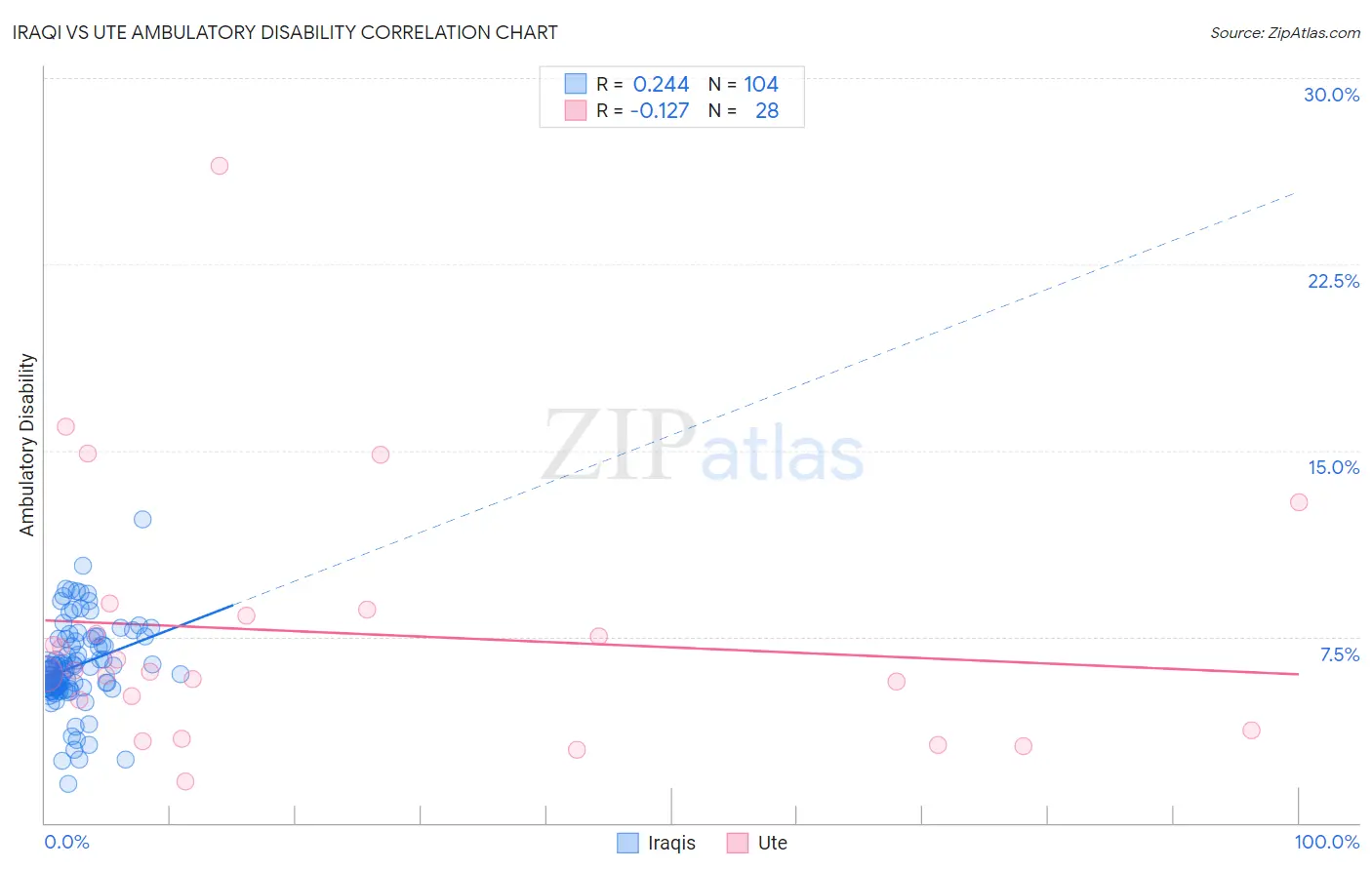Iraqi vs Ute Ambulatory Disability
COMPARE
Iraqi
Ute
Ambulatory Disability
Ambulatory Disability Comparison
Iraqis
Ute
6.1%
AMBULATORY DISABILITY
62.8/ 100
METRIC RATING
166th/ 347
METRIC RANK
6.0%
AMBULATORY DISABILITY
86.6/ 100
METRIC RATING
134th/ 347
METRIC RANK
Iraqi vs Ute Ambulatory Disability Correlation Chart
The statistical analysis conducted on geographies consisting of 170,645,130 people shows a weak positive correlation between the proportion of Iraqis and percentage of population with ambulatory disability in the United States with a correlation coefficient (R) of 0.244 and weighted average of 6.1%. Similarly, the statistical analysis conducted on geographies consisting of 55,667,207 people shows a poor negative correlation between the proportion of Ute and percentage of population with ambulatory disability in the United States with a correlation coefficient (R) of -0.127 and weighted average of 6.0%, a difference of 1.8%.

Ambulatory Disability Correlation Summary
| Measurement | Iraqi | Ute |
| Minimum | 1.6% | 1.7% |
| Maximum | 12.2% | 26.5% |
| Range | 10.7% | 24.8% |
| Mean | 6.3% | 7.6% |
| Median | 6.2% | 6.1% |
| Interquartile 25% (IQ1) | 5.4% | 4.3% |
| Interquartile 75% (IQ3) | 7.4% | 8.5% |
| Interquartile Range (IQR) | 2.0% | 4.1% |
| Standard Deviation (Sample) | 1.7% | 5.2% |
| Standard Deviation (Population) | 1.7% | 5.1% |
Similar Demographics by Ambulatory Disability
Demographics Similar to Iraqis by Ambulatory Disability
In terms of ambulatory disability, the demographic groups most similar to Iraqis are Nicaraguan (6.1%, a difference of 0.020%), Basque (6.1%, a difference of 0.050%), Immigrants from Oceania (6.1%, a difference of 0.12%), Ecuadorian (6.1%, a difference of 0.13%), and Lebanese (6.1%, a difference of 0.20%).
| Demographics | Rating | Rank | Ambulatory Disability |
| Immigrants | Latvia | 71.1 /100 | #159 | Good 6.0% |
| Central Americans | 69.8 /100 | #160 | Good 6.0% |
| Immigrants | Belarus | 69.2 /100 | #161 | Good 6.1% |
| Nigerians | 67.1 /100 | #162 | Good 6.1% |
| Lebanese | 66.2 /100 | #163 | Good 6.1% |
| Basques | 63.7 /100 | #164 | Good 6.1% |
| Nicaraguans | 63.2 /100 | #165 | Good 6.1% |
| Iraqis | 62.8 /100 | #166 | Good 6.1% |
| Immigrants | Oceania | 60.7 /100 | #167 | Good 6.1% |
| Ecuadorians | 60.5 /100 | #168 | Good 6.1% |
| Immigrants | Southern Europe | 58.1 /100 | #169 | Average 6.1% |
| Immigrants | Ecuador | 53.8 /100 | #170 | Average 6.1% |
| Moroccans | 52.6 /100 | #171 | Average 6.1% |
| Immigrants | Burma/Myanmar | 52.2 /100 | #172 | Average 6.1% |
| Croatians | 51.2 /100 | #173 | Average 6.1% |
Demographics Similar to Ute by Ambulatory Disability
In terms of ambulatory disability, the demographic groups most similar to Ute are Immigrants (6.0%, a difference of 0.040%), Immigrants from Europe (6.0%, a difference of 0.15%), Immigrants from Italy (6.0%, a difference of 0.18%), Immigrants from North Macedonia (6.0%, a difference of 0.27%), and Immigrants from Syria (6.0%, a difference of 0.27%).
| Demographics | Rating | Rank | Ambulatory Disability |
| Immigrants | Nigeria | 90.9 /100 | #127 | Exceptional 5.9% |
| Immigrants | Western Asia | 90.7 /100 | #128 | Exceptional 5.9% |
| Immigrants | Norway | 90.5 /100 | #129 | Exceptional 5.9% |
| Immigrants | Kazakhstan | 89.7 /100 | #130 | Excellent 5.9% |
| Immigrants | Costa Rica | 89.5 /100 | #131 | Excellent 5.9% |
| Immigrants | Europe | 87.8 /100 | #132 | Excellent 6.0% |
| Immigrants | Immigrants | 86.9 /100 | #133 | Excellent 6.0% |
| Ute | 86.6 /100 | #134 | Excellent 6.0% |
| Immigrants | Italy | 85.0 /100 | #135 | Excellent 6.0% |
| Immigrants | North Macedonia | 84.1 /100 | #136 | Excellent 6.0% |
| Immigrants | Syria | 84.1 /100 | #137 | Excellent 6.0% |
| Immigrants | Hungary | 83.9 /100 | #138 | Excellent 6.0% |
| Immigrants | Zaire | 83.6 /100 | #139 | Excellent 6.0% |
| Czechs | 83.3 /100 | #140 | Excellent 6.0% |
| Swedes | 83.1 /100 | #141 | Excellent 6.0% |